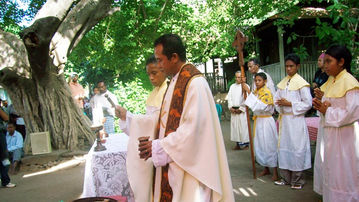
Whaling as a way of life
OVERVIEW
2007 - 2008
One of the last true traditional whaling villages in the world, Lamalera lies on the island of Lembata and survives on a barter economy by exchanging whale meat for vegetables and other commodities with surrounding villages. Different organizations have teamed up with the Indonesian government to designate the Savu Sea - famed for Lamalera's traditional whaling - a Marine Protected Area, while at the same time engaging the local communities into the decision-making process. Photovoices was used as a public engagement tool to provide visual community-based information directly from the perspectives of the people of Lamalera.
44
members of Lamalera local community shared their perspectives
6
students were selected to represent the view of the youth
20,322
photographs produced
262
photos and accompanying stories exhibited
HIGHLIGHTS
Traditional Whaling Culture
Whaling has been a way of life in Lamalera for nearly six hundred years. Whalers in Lamalera combine ancient animistic traditions and the recent adoption of Christianity in their daily rituals and ceremonies, from making the traditional harpoon to calling the whales before the hunt.
Shared Commodities
Once caught, the whale is brought back to Lamalera and divided among the villagers for food, and to be brought to the inland market. Adult whales can weigh up to 50 tons, so quartering an animal this large requires everyone in the village to pitch in and help.
Subsistence Fishing in Lamalera
Whales may be the primary source of meat for the people of Lamalera, but when the whales are not available the villagers turn to subsistence fishing to feed their families. Flying fish are a favorite, but the fishing grounds near the village also have tuna, manta rays, sharks, and more.
Lamalera School Club
The Lamalera School Club was initiated by Photovoices Indonesia coordinator Saraswati. The club initially provided cameras to six students from the Lamalera middle school, and with the huge success of the program, it has grown to become a permanent part of the curriculum for all the students.
The Daily Life in Lamalera
In their daily activities, while weaving traditional cloth for sarongs or sifting rice for meals, the people of Lamalera always keep an eye on the horizon for the chance of spotting a passing whale. This gallery showcases photographs taken by the villagers, presenting an intimate portrait of the village.
The Daily Life in Lamalera
In their daily activities, while weaving traditional cloth for sarongs or sifting rice for meals, the people of Lamalera always keep an eye on the horizon for the chance of spotting a passing whale. This gallery showcases photographs taken by the villagers, presenting an intimate portrait of the village.
“Before, people from outside came to take pictures and we didn’t know what they were for. But now we take our own pictures, and through them we learned much about our nature, culture and also created important information that we leave for our next generation.”
Fransiskus Use Bataona, Clan Leader from Lamalera Village
Passing on the stories
At the end of the Photovoices project, village officials and traditional leaders asked to extend the project—not to take more pictures—but to take time to get deeper stories about some of the 17,000 pictures produced by the project and use them as a way to reintroduce ancient stories to the young.
Getting involved in the dialogue
In March, a meeting took place in Bali with one of the world’s leading sperm whale experts, marine biologists, leaders from WWF-Indonesia, and others. The meeting was led entirely by the Lamalera people, who presented their pictures and stories behind the pictures and summarised their hopes for the future.
Becoming Part of the Local Curriculum
Photovoices initiated Lamalera School Club, and it was so successful that the Principal asked and received permission for Photovoices to become a permanent part of the curriculum. The cameras used for the project were donated by Photovoices to the Lamalera Middle School.
Engaging the Local Government
The Photovoices pictures and stories will be submitted in a report to the government as part of a Lamalera Photovoices exhibit that will be held in September at the Culture Museum in Kupang, Timor.












